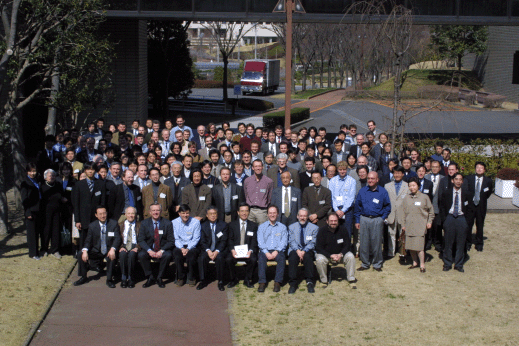@The international symposium named MS+S2002 was held on March 4-6, 2002, at the NTT Atsugi R&D Center in collaboration with New Energy and Industrial Technology Development Organization (NEDO) and the Physical Society of Japan (JPS). A field of physics called "Mesoscopic Superconductivity" includes Andreev reflection, a superconductor/ferromagnet system, a p-junction, quantum coherence and a quantum bit. Spintronics, that is made from spin and electronics, includes spin-related transport phenomena and ferromagnetic semiconductors, etc. NTT Basic Research Laboratories has led both fields, and the symposium aspired to gather the leading scientists and discuss the most recent topics.
@Dr. Sunao Ishihara, Director of NTT Basic Research Laboratories, opened the symposium with welcoming remarks. Next, Dr. Hideaki Takayanagi, NTT R&D Fellow, Executive Manager of NTT Basic Research Laboratories, gave a keynote address.
@Oral sessions consisted of 51 presentations by invited speakers and contributed ones. Poster sessions had 62 presentations. Prof. J. Clarke of University of California, Berkeley, the inventor of a superconducting interference device (SQUID), gave a plenary talk entitled "The DC SQUID: From Traditional Designs to New Ideas for Quantum Measurement". This was followed by the observations of the quantum superposition and Rabi oscillations were discussed in a SQUID as well as an ultrasmall superconducting dot. The time-domain measurements of the Q-bit state were also reported by Chalmers University (Sweden) and Yale University. We reported one-shot measurement of the Q-bit state by a dc-SQUID.
@One of the main subjects in Spintronics was the spin-injection effect. Prof. E. Rashba of MIT, who is famous for his pioneering work "Rashba effect", discussed that spin injection was the key to many new phenomena and applications in the field of the spin-polarized electron transport. In the symposium we proposed a spin filter that utilized Rashba effect in a resonant tunneling structure.
@The participants were 190 people [companies and universities: 149 (overseas: 64, domestic: 126), NTT: 41]. Many participants were strongly impressed by the high quality of the presentations. The proceedings will be published in the special book by World Scientific. The symposium was recorded on videotape and the tape has been used for public relations.
